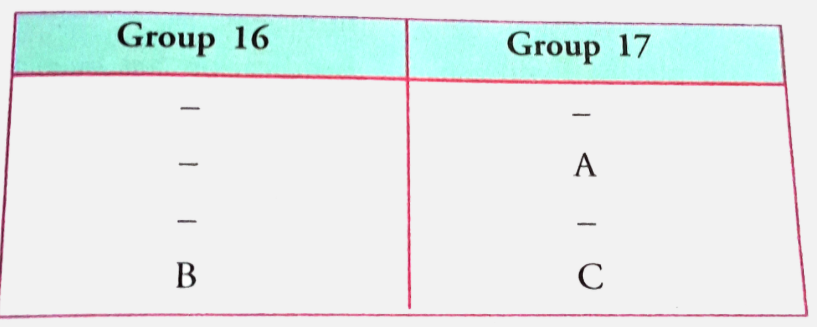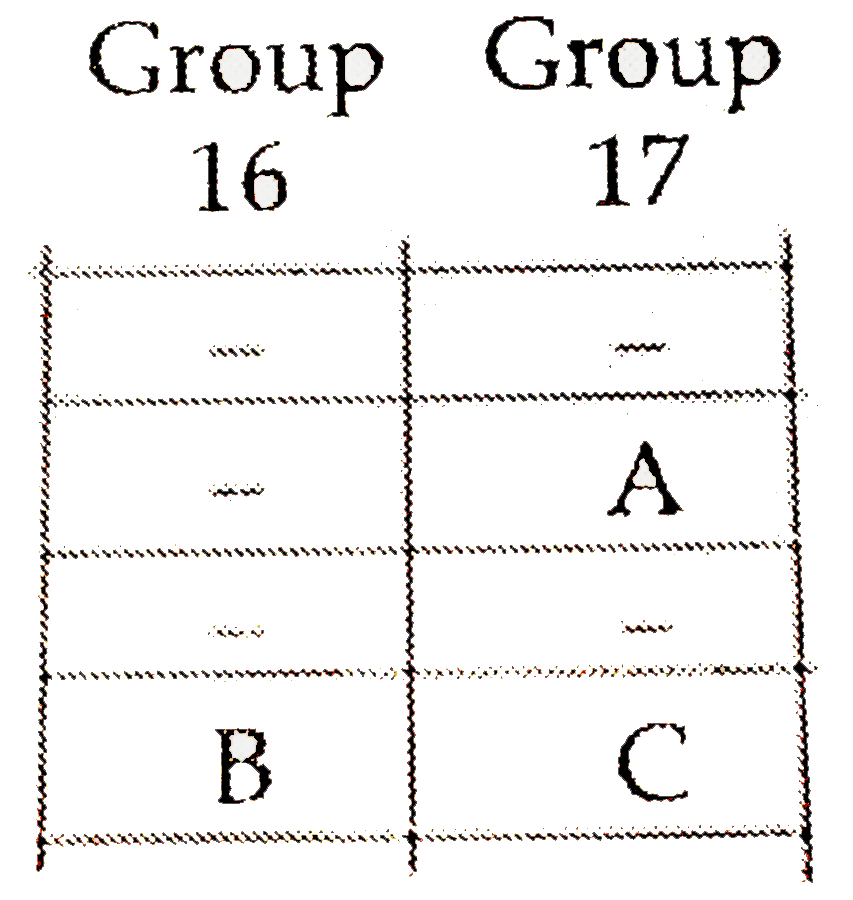The positions of three elements A, B and C in the periodic table are shown below:
State whether C is more reactive or less reactive than A.
To determine whether element C is more reactive or less reactive than element A, we need to analyze their positions in the periodic table and understand the trends in reactivity for non-metals.
1. Identify the Groups:
- Element A is in Group 17 (the halogens).
- Element C is also in Group 17 (the halogens).
- Element B is in Group 16.
2. Understand the Reactivity of Non-Metals:
- In the periodic table, non-metals tend to gain electrons to achieve a stable electronic configuration. The reactivity of non-metals increases as you move up a group because the atomic size decreases, leading to a stronger attraction between the nucleus and the incoming electrons.
3. Compare the Positions of A and C:
- Since both A and C are in Group 17, we need to determine their relative positions.
- If A is above C in the periodic table, then A is smaller in size compared to C.
4. Analyze the Size and Effective Nuclear Charge (Z-effective):
- As you move down a group, the atomic size increases due to the addition of electron shells. This increase in size reduces the effective nuclear charge experienced by the valence electrons.
- A smaller atomic size (like that of A) means a higher Z-effective, which leads to greater reactivity for non-metals.
5. Conclusion:
- Since A is above C in Group 17, A is more reactive than C. Therefore, C is less reactive than A.
Final Answer:
C is less reactive than A.
---
- Element A is in Group 17 (the halogens).
- Element C is also in Group 17 (the halogens).
- Element B is in Group 16.
- In the periodic table, non-metals tend to gain electrons to achieve a stable electronic configuration. The reactivity of non-metals increases as you move up a group because the atomic size decreases, leading to a stronger attraction between the nucleus and the incoming electrons.
- Since both A and C are in Group 17, we need to determine their relative positions.
- If A is above C in the periodic table, then A is smaller in size compared to C.
- As you move down a group, the atomic size increases due to the addition of electron shells. This increase in size reduces the effective nuclear charge experienced by the valence electrons.
- A smaller atomic size (like that of A) means a higher Z-effective, which leads to greater reactivity for non-metals.
- Since A is above C in Group 17, A is more reactive than C. Therefore, C is less reactive than A.
C is less reactive than A.
Topper's Solved these Questions
- BOOK - MTG IIT JEE FOUNDATIONCHAPTER - PERIODIC CLASSIFICATION OF ELEMENTSEXERCISE - Exercise (Multiple Choice Questions Level-1)30videos
PERIODIC CLASSIFICATION OF ELEMENTS
- BOOK - MTG IIT JEE FOUNDATIONCHAPTER - PERIODIC CLASSIFICATION OF ELEMENTSEXERCISE - Exercise (Multiple Choice Questions Level-2)20videos
PERIODIC CLASSIFICATION OF ELEMENTS
- BOOK - MTG IIT JEE FOUNDATIONCHAPTER - PERIODIC CLASSIFICATION OF ELEMENTSEXERCISE - Solved Examples37videos
PERIODIC CLASSIFICATION OF ELEMENTS
- BOOK - MTG IIT JEE FOUNDATIONCHAPTER - MOLE CONCEPT, STOICHIOMETRY AND BEHAVIOUR OF GASES EXERCISE - EXERCISE (INTEGER/NUMERICAL VALUE TYPE)5videos
MOLE CONCEPT, STOICHIOMETRY AND BEHAVIOUR OF GASES
Similar Questions
The positions of three elements A, B and C in the periodic table are shown below:
Group 16Group 17−−−A−−BC
State whether A is metal or non-metal.View SolutionThe position of three elements A, B and C in the Periodic Table are shown below :
Group 16Group 17−−−A−−BC
(a) State whether A is a metal or non-metal.
(b) State whether C is more reactive or less reactive than A.
(c) Will C be larger or smaller in size than B?
(d) Which type of ion, cation or anion, will be formed by element A ?View Solution
Knowledge Check
- Question 1 - Select One
Elements of group 17 of the periodic table are called
Aalkali metalsBrare elementsChalogensDtransition metals
The positions of three elements A, B and C in the periodic table are shown below:
Group 16Group 17−−−A−−BC
Will C be larger or smaller in size than B?View SolutionThe position of three elements A, B and C in the Periodic Table are shown below –
Group16Group17−−−A−−BC
(a) State whether A is a metal or non-metal.
(b) State whether C is more reactive or less reactive than A.
(c) Will C be larger or smaller in size than B?
(d) Which type of ion, cation or anion, will be formed by element A?View SolutionThe positions of three elements A, B and C in the periodic table are shown below:
Group 16Group 17−−−A−−BC
Which type of ion, cation or anion will be formed by the element A?View SolutionThe position of three elements A, B and C in the Periodic Table are shown below:

(a) State whether A is a metal or a non-metal.
(b) State whether C is more reactive or less reactive than A.
(c) Will C be larger or smaller in size than B?
(d) Which type of ion-cation or anion will be formed by element A?View SolutionThe position of three elements A, B and C in che periodic table are shown below :

(a) State whether A is metal or non-metal.
(b) Seate whether C is more reactive or less reactive than A.
(c) Will C be larger or smaller in size than B ?
(d) Which type of ion, cation or anion will be formed by the element A ?View SolutionThe positions of three elements A,B and C in the periodic table are shown here
(a) State whether A is a metal or non-metal?

State whether C is more reactive or less reactive than A
(c) Will C be larger or smaller in size than B?
(d) Which type of ion, cation or anion, will be formed by element A?View SolutionThe position of three elements A, B and C in the Periodic table are shown below :

Will C be larger or smaller in size than B?View Solution
